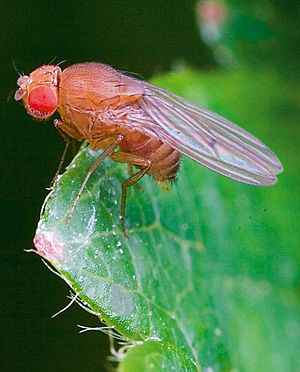Drosophila simulans facts for kids
Quick facts for kids Drosophila simulans |
|
|---|---|
 |
|
| Drosophila simulans adult female | |
| Scientific classification | |
| Kingdom: | |
| Phylum: | |
| Class: | |
| Order: | |
| Genus: | |
| Subgenus: |
Sophophora
|
| Species group: |
melanogaster group
|
| Species subgroup: |
melanogaster subgroup
|
| Species complex: |
simulans complex
|
| Species: |
D. simulans
|
| Binomial name | |
| Drosophila simulans Sturtevant, 1919
|
|
Drosophila simulans is a type of tiny fly, often called a fruit fly. It looks a lot like its close relative, D. melanogaster, which is another common fruit fly. Scientists often study these flies to learn about genetics and how new species come to be.
Discovering the D. simulans Fruit Fly
This fly was first identified in 1919 by a scientist named Alfred Sturtevant. He was working in a lab at Columbia University where they studied fruit flies. Sturtevant noticed that what they thought was just one type of fly, D. melanogaster, was actually two different species! One was D. melanogaster, and the other was D. simulans.
How Are They Different?
It can be tricky to tell D. simulans and D. melanogaster apart. Male flies have small differences in their body parts that help scientists tell them apart. Female flies can also be identified by their color, but it takes a trained eye to spot the differences.
When these two types of flies try to have babies together, their offspring often cannot have babies of their own. This is a sign that they are indeed different species.
D. simulans and New Species
D. simulans is also closely related to two other types of fruit flies. These are Drosophila sechellia and Drosophila mauritiana. These two species are found only on certain islands.
Scientists have found that D. simulans can mate with these island species. When they do, the female offspring can have babies, but the male offspring cannot. This makes D. simulans a very important fly for studying speciation. Speciation is the process where new species form over time. By studying these flies, scientists can learn more about how different species come to be.

